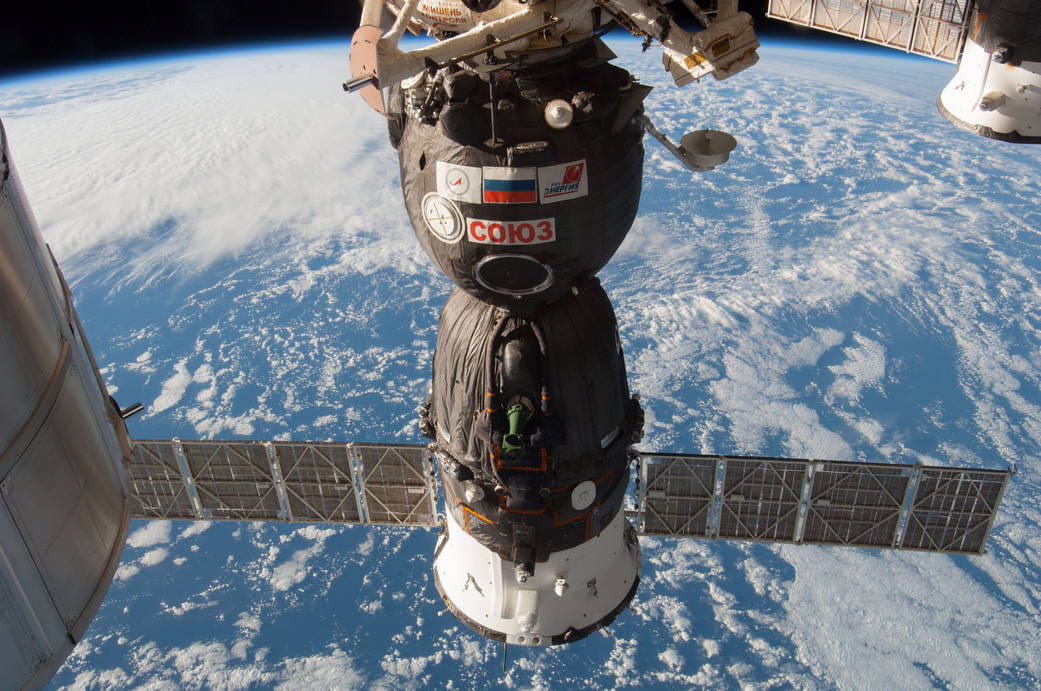Highlights
Roscosmos is the industry’s hub for government-owned and joint-stock corporations.
Russian space law identifies the use of the space program for national security.
Russia’s space industry is deeply embedded in the global space market.
SPARC Brief
Russia
June 2020

Overview
With the collapse of the USSR, Russia inherited a sprawling state-owned space sector with numerous industries and organizations. In 1992, these were regrouped under a unitary state institution, the Russian Federal Space Agency. Now known as Roscosmos, it is the coordinating hub for space activities, serving both civilian and military needs.
At the domestic level, despite large-scale restructuring since 2010, Roscosmos inclined towards revamping Soviet-era technologies and practices rather than innovation. To rectify this, Russia renationalized its space sector in 2015 to attract global investments for technology, innovation, and productivity. It is positioning to embed itself even deeper in the global space market. At the international level, Roscosmos has been an important and reliable partner on the International Space Station (ISS), ferrying crew and personnel from around the world. While it recognizes the use of space for security and defense, Russia has also been a consistent advocate for the prevention of an arms race in outer space.
Industrial Base
As a leading space power, Russia possesses a wide range of technologies: both manned and unmanned spacecraft, launch vehicles, rocket engines, and launching platform complexes. Russia is a key player in the International Space Station (ISS), manufacturing component modules and providing transportation. It also maintains three major launch sites where national and privately contracted spacecrafts are launched: the Baikonur, Plesetsk, and Vostony cosmodromes.
Russian companies are capable of producing various launch vehicles that are actively being used and marketed worldwide.
Russian companies are capable of producing various launch vehicles that are actively being used and marketed worldwide: Soyuz systems fly astronauts to the ISS, and the Proton and Angara family launch vehicles take satellites to geostationary orbits.
Roscosmos is the industry’s hub for government-owned and joint-stock corporations. Today, almost all the relevant corporations and research institutions operate under its auspices. There are four key players of note.
RSC Energia is a primary contractor for the ISS, training and dispatching cosmonauts to the station. It manufactures and transports the necessary modules to space. It also maintains a launch center, the Baikonor Cosmodrome, both housing multiple corporations and diverse actors on the site. It also produces the Yamal series of communication and remote sensing satellites.
The Khrunichev Space Center is more commercially oriented compared to the other space agencies. It produces the Proton M and Angara rockets, as well as the Baikai reusable launch vehicles. Khrunichev’s products also include upper-stage booster blocks such as Breeze M, Breez KM, and the 12KRB upper stage.
The Progress Rocket Space Center makes the Soyuz FG and Soyuz-U launch vehicles, for manned spacecrafts and robots, respectively. It also produces the Foton and Foton-M science satellites, the Yanter military satellites, and the Resurs DK Earth Resource satellites.
NPO Energomash is a world-renowned rocket engine manufacturer for its RD series: RD-170/171, RD-180, RD-181, RD-191, etc.
Two indigenous space technology capabilities are worthy of attention: a laser cannon for cleaning space debris and a nuclear-powered rocket. In 2018, Precision Instrument Systems, one of the affiliated companies of Roscosmos, reportedly created a laser cannon for blasting space debris. It attempted to use the massive telescope at the Altay Optical-Laser Center to locate space junk, and then shoot down the debris by vaporizing it with laser heat. The Keldysh Research Center is building the Transport and Energy Module (TEM), a nuclear propulsion spacecraft geared towards Mars exploration that would not require cleaning or new parts before its return journey to Earth.
Law & Policy
Russia’s space law designates the Kremlin as the principal decision-maker in space-related programs and policies[1]. The head of Roscosmos (presently Dmitry Rogozin) is more than a bureaucrat for a government agency; he is also an influential politician who manages all the space programs and related security policies. He is the point person for military, security, and foreign policy issues that involve technologies developed for the space program.
The important principles and guidelines that govern the activities of the space program in Russia are stipulated in the Federal Law No. 5663-1[2]. Since its adoption in 1993, it has reflected the evolving course of the Russian space development and policies. The law defines the scope of space activities, namely scientific research, technology uses, manned space flights, and so on.
This Federal Law stipulates that space activities are subject both to Russian laws and international treaties signed by Russia[3]. The government defers to internationally recognized norms and treaties on such matters as orbital debris or space objects that are jointly owned by multinational entities[4]. What is characteristic of the law is how it relates space policies to the security of Russia. In article 2, one of the areas of space activities includes “the use of space technology, space materials and space technology in the interests of the defense and security of the Russian Federation.” In article 3, “assistance in strengthening the defense and ensuring the security of the Russian Federation” is noted. The term “dual-use space technology” first appears in article 4. As such, Russian space law, in principle, recognizes the need and intent to use the space program for military purposes in the name of national security.
International Engagements
Russia’s space industry is deeply embedded in the global space market. Though Roscosmos is a government agency owned and run by the state, many of its subsidiaries are in the form of joint-stock corporation, which rely on private and foreign investments and engage through affiliated companies overseas. Overall, Russia engages in the commercialized space market, promoting its technologies, launch capabilities, and human capital to both advanced players such as the United States and others such as Kazakhstan and South Korea.
For example, “Sea Launch”[5] is a representative multinational collaborative project, involving Roscosmos, Energia, Boeing, and other contractors from Norway and Ukraine. Russia’s core space technologies, such as the RD-180 rocket engines and in-space electric propulsion, are indispensable to customers like NASA, SpaceX, and Lockheed Martin.
Russia delivered the KazSat space communications system for Kazakhstan, including the ground-based infrastructure for controlling the spacecraft in flight. Russia’s Khrunichev Center helped South Korea (KARI – Korean Aerospace Institute) build its own space rocket complex that successfully launched a spacecraft, STSAT-2C, into orbit in 2013.
Aside from selling its space technologies to global customers, Russia is interested in cooperating on a larger scale with burgeoning space-powers[6]. In 2019, Russia and India embarked on a joint project to send Indian astronauts to the ISS (Project Gaganyaan) in 2022. Russia also began a new collaboration with China on the lunar exploration project, which will involve Russia’s Luna-26 orbiter spacecraft and China’s Chang’e-7 polar landing mission.
Trajectories
Through its domestic legal framework, Russia officially affirms its principle to comply with its obligations under the international space treaties. While its laws allow the use of space technologies for purposes of its defense and security, Russia is a strong advocate of banning weaponization in outer space.
Russia is a strong advocate of banning weaponization in outer space.
Russia’s position on the weaponization of outer space is manifested in its United Nations draft resolution, the Prevention of the Placement of Weapons in Outer Space, and of the Threat or Use of Force against Outer Space Objects (PPWT)[7]. This was submitted to the Committee on Disarmament in the United Nations with China in 2008 (an updated version was submitted once again in 2014). Russia wants this to become a binding international treaty on space weaponization eventually. The core content of the draft is to prohibit any nations from placing weapons in outer space.
The United States vetoed this draft resolution, criticizing its lack of verifiability and its disregard of the ground-based ASAT weapons[8], such as soft-kill weapons using lasers to disable satellites. Other critics point out that the PPWT dismisses the issue of space debris or the potential use of cleaning technologies to attack other orbital spacecrafts.
Russia sees a legally binding international treaty as a way to level the playing field in the space weaponization race[9]. For the foreseeable future, Russia will continue to attempt to lead the formation of international norms of weaponization of outer space. This may advantage it vis-à-vis both Europe and the United states in garnering the support of the international community. Looking ahead, its potential partnership with China is also a way to balance the United States in military space realities.
Endnotes
[1] The Federal Law No. 5663-1, Article 5 unequivocally assigns the chief authority over Russian space policies and program to the President of the Russian Federation (currently Vladimir Putin) and the Russian government the right to implement them.
[2] The Federal Law No. 5663-1 (Aug 20, 1993), “On Space Activities (О космической деятельности)”. The full text of the law is available at http://www.consultant.ru/document/cons_doc_LAW_3219/ (Retrieved April 5, 2020).
[3] In the Federal Law No. 5663-1, Article 1, international treaties are broadly indicated as “generally recognized principles and norms of international law and international treaties of the Russian Federation.” In the remaining part of the Federal Law, it does not specify the names of international treaties to adhere to, including the outer space treaty.
[4] Refer to the Federal Law No. 5663-1 (Aug 20, 1993), Article 17(4), Article 20(5).
[5] Until recently, RSC Energia also controlled Sea Launch, but its ownership was transferred to the S7 Group due to increasing operational costs.
[6] Aliberti, M. & Lisitsyna, K. (2018). Russia’s Posture in Space: Prospects for Europe, ESPI Report, European Space Policy Institute, at https://espi.or.at/publications/espi-public-reports/category/2-public-espi-reports (Retrieved May 20, 2020).
[7] The text of the PPWT is available at https://digitallibrary.un.org/record/633470/files/CD_1839-EN.pdf (Retrieved May 15, 2020)
[8] The U.S. publicly criticized the contents of the proposed draft and its sequentially updated versions in the CD (Conference on Disarmament) plenary at the United Nations. See the transcript of a speech made by US ambassador Robert Wood, at https://geneva.usmission.gov/2014/09/09/ambassador-robert-wood-ensuring-the-long-term-sustainability-and-security-of-the-space-enviroment/ (Retrieved April 10, 2020)
[9] For more discussion on the positions of Russia and China in drafting the resolution, see: Cristina Hansell & Nikita Perfilyev (2009) TOGETHER TOWARD NUCLEAR ZERO, The Nonproliferation Review, 16:3, 435-461, DOI: 10.1080/10736700903255110, (Retrieved May 14th, 2020); and Alexey Arbatov (2019) Arms control in outer space: The Russian angle, and a possible way forward, Bulletin of the Atomic Scientists, 75:4, 151-161, DOI: 10.1080/00963402.2019.1628475 (Retrieved May 14, 2020).
Dr. Seonhee Kim is a postdoctoral researcher at the Harriman Institute at Columbia University.
The views expressed in this SPARC Brief are those of the author, and do not reflect the official policy or position of SPARC or the University of Washington.
